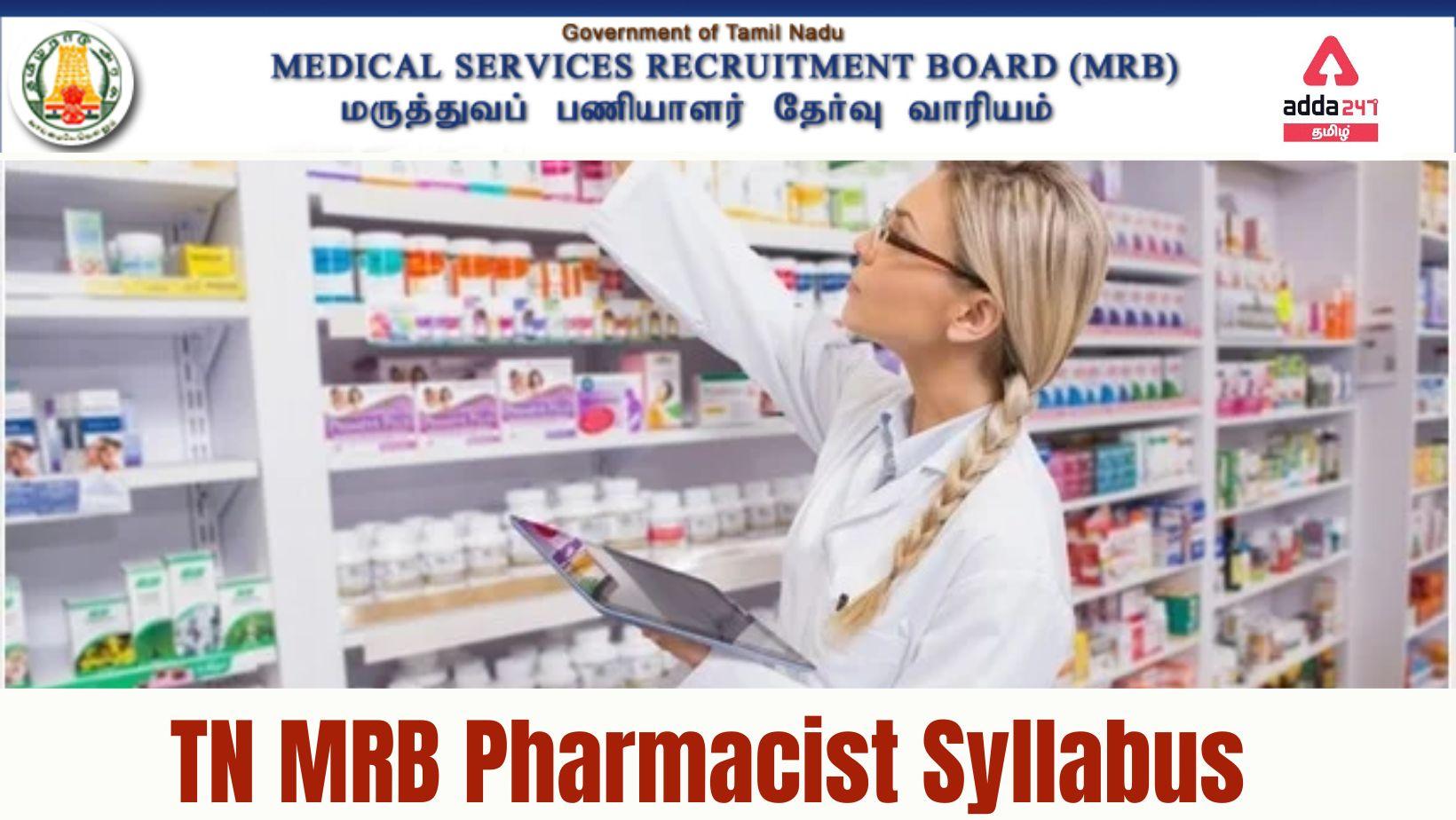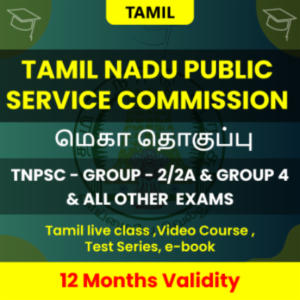Table of Contents
TN MRB Pharmacist Syllabus 2022: Tamil Nadu Medical Services Recruitment Board (TN MRB) has released the TN MRB Recruitment 2022 Notification to recruit 889 Pharmacist. Syllabus plays an important role in Exam Preparation. Interested Candidates can check the detailed TN MRB Pharmacist Syllabus and Exam Pattern here.
|
TN MRB Pharmacist Syllabus 2022 |
|
| Organization | Tamil Nadu Medical Services Recruitment Board |
| Post | Pharmacist |
| No of vacancies | 889 |
| Job Location | Tamilnadu |
| Starting Date | 10.08.2022 |
| Last Date | 30.08.2022 |
| Official Website | www.mrb.tn.gov.in |
Fill the Form and Get All The Latest Job Alerts
TN MRB Pharmacist Syllabus
TN MRB Pharmacist Syllabus: தமிழ்நாடு மருத்துவப் பணிகள் ஆட்சேர்ப்பு வாரியம் (TN MRB) மருந்தாளுநர் பணிக்கான அறிவிப்பை 10.08.2022 அன்று வெளியிட்டுள்ளது. ஆர்வமும் விருப்பமும் உள்ள விண்ணப்பதாரர்கள் ஆன்லைனில் 10.08.2022. லிருந்து 30.08.2022 க்குள் விண்ணப்பிக்கலாம். தேர்வுக்கு தயாராகும் முன் தேர்வுமுறை பற்றிய தெளிவு பெறுவது மிக அவசியம். தேர்வுக்கான பாடத்திட்டம் மற்றும் தேர்வுமுறைகள் பற்றிய முழு தகவல்களையும் இந்த கட்டுரையில் வழங்கியுள்ளோம். தேர்வுக்கு தயாராகும் தேர்வர்கள் கட்டுரையை முழுமையாக படிக்கவும்.

TN MRB Pharmacist Syllabus 2022
TN MRB Pharmacist Syllabus 2022: தமிழ்நாடு மருத்துவப் பணிகள் ஆட்சேர்ப்பு வாரியம் (TN MRB) மருந்தாளுநர் பணிக்கான தேர்வுக்கான பாடத்திட்டம்.
DIPLOMA IN PHARMACY SYLLABUS
(1) PHARMACEUTICS: Definition, types, theoretical and practical aspects, methods of preparation/formulation, vehicles, adjuvants and excipients used, quality control, containers and closures, special labelling requirements and storage conditions etc. of (a) Solid dosage forms – powders, granules, cachets and tablet triturates, tablets and capsules. (b) Liquid dosage forms: mixtures, syrups, elixirs, gargles, mouthwashes, throat paints, douches, ear drops, nasal drops, sprays, liniments, lotions, suspensions and emulsions (c) Semi-solid dosage forms – ointments, pastes, jellies, poultices, suppositories and pessaries. (d) Dental and Cosmetic Preparation – dentrifices, facial cosmetics, deodorants, antiperspirants, shampoos, hair dressing and hair removers. (e) Sterile Dosage Forms: (i) Parenteral dosage forms – preparation of Intravenous fluids and admixtures – Total parenteral nutrition, – Dialysis fluids – Sterility testing – Particulate matter monitoring – Faulty seal packaging and (ii) Ophthalmic Products – study of essential characteristics of different ophthalmic preparations – formulation additives, special precautions in handling and storage of ophthalmic products. Study of immunological products like sera vaccines, toxoids & their preparations. and introduction to Ayurvedic dosage forms.
Prescriptions – Latin terms commonly used in prescriptions- Modern methods of prescribing, adoption of metric system. Calculations involved in dispensing – Incompatibilities in Prescriptions – Study of various types of incompatibilities – Posology – dose and Dosage of drugs – factors influencing dose – calculations of doses on the basis of age, sex and surface area – veterinary doses.
Systems of weights and measures – calculations including conversion from one to another system. Percentage calculations and adjustments of products. Use of alligation method in calculations, Isotonic solutions. Introduction to Pharmacopoeias with special reference to the Indian Pharmacopoeia.
Read More: TN MRB Recruitment 2022, Apply for 889 Pharmacist Posts
Definition, theory, objectives, types, factors influencing, advantages and disadvantages, uses and equipments for the following processes: (a) Size reduction, (b) Size separation (c) Mixing and homogenisation, (d) Clarification and filtration (e) Extraction (f) Distillation (g) Drying (h) Sterilization (i) Aseptic techniques etc.
(2) PHARMACEUTICAL CHEMISTRY: General discussion on the following inorganic compounds including important physical and chemical properties, medicinal and pharmaceutical uses, storage conditions and chemical incompatibility belonging to to following categories: (A) Acids, bases and buffers (B) Antioxidants (C) Gastrointestinal agents including acidifying agents, antacids, protectives and saline cathartics (D) Topical Agents including protectives, antimicrobials and astringents (E) Dental Products (F) Inhalants (G) Respiratory stimulants (H) Expectorants and Emetics and (I) Antidotes-Sodium nitrate.
Major Intra and Extracellular electrolytes: (A) Electrolytes used for replacement therapy (B) Physiological acid-base balance and electrolytes (C) Combination of oral electrolyte powders and solutions.
Radio pharmaceuticals and Contrast media: Radio activity-Alpha, Beta and Gamma Radiations, Biological effects of radiations, Measurement of radio activity, G. M. Counter Radio isotopes their uses, storage and precautions with special reference to the official preparations.
Quality control of Drugs and Pharmaceuticals -Importance of quality control, significant errors, methods used for quality control, sources of impurities in Pharmaceuticals, Limit tests for Arsenic, chloride, sulphate, Iron and Heavy metals and Identification tests for cations and anions as per Indian Pharmacopoeia.
Chemistry of following pharmaceutical organic compounds, covering their nomenclature, chemical structure, uses and the important physical and chemical properties, stability and storage conditions and the different type of pharmaceutical formulations of these drugs and their popular brand names of drugs belonging to: (a) Antiseptics and disinfectants (b) Sulfonamides (c) Antileprotic drugs (d) Antitubercular drugs (e) Antiamoebic and Anthelmintic drugs (f) Antibiotics – Penicillins Gentamicin, Neomycin , Erythromycin , Tetracyclines, Cephalosporins exin, Cephaloridine , Cephalothin, Griseofulvin , Chloramphenicol. (g) Antifungal agents (h) Antimalarial Drugs. (i) Tranquilizers (j) Sedatives and Hypnotics (k) General and Local Anaesthetics (l) Antidepressant drugs (m) Analeptics (n) Adrenergic and Adrenergic Antagonist drugs (o) Cholinergic and Anti-cholinergic Drugs (p) Diuretics (q) Cardiovascular Drugs (r) Hypoglycemic Agents (s) Coagulants and AntiCoagulants (t) Histamine and Anti-histaminic Agents (u) Analgesics and Anti-pyretics (v) Non-steroidal anti-inflammatory Agents (w) Diagnostic Agents (x) Anticonvulsants (y) Cardiac glycosides (z) Antiarrhythmic agents (aa) Antihypertensives (ab) Vitamins. (ac) Steroidal Drugs (ad) Anti-Neoplastic drugs.
BIS ஆட்சேர்ப்பு 2022, குரூப் A, B மற்றும் Cக்கான பல்வேறு பதவிகள்
(3) PHARMACOGNOSY: Definition, history and scope of Pharmacognosy including indigenous system of medicine – various systems of classification of drugs of natural origin – adulteration and drug evaluation – significance of pharmacopoeial standards.
Brief outline of occurrence, distribution, outline of isolation, identification tests, therapeutic effects and pharmaceutical applications of alkaloids, terpenoids, glycosides, volatile oils, tannins and resins
Occurrence, distribution, organoleptic evaluation, chemical constituents including identification tests, pharmaceutical applications of following categories of drugs (a) Laxatives: Aloes, Rhuburb, Castor oil, Ispaghula, Senna. (b) Cardiotonics: Digitalis, Arjuna.(c) Carminatives & G.I. regulators: Umbelliferous fruits, Coriander, Fennel, Ajowan, Cardamom Ginger, Black pepper, Asafoetida, Nutmeg, Cinnamon, Clove. (d) Astringents – Catechu. (e) Drugs acting on nervous system- Hyoscyamus, Belladonna, Aconite, Ashwagandha, Ephedra, Opium, Cannabis, Nux vomica. (f) Antihypertensives – Rauwolfia. (g) Antitussives – Vasaka, Tolu balsam, Tulsi. (h) Antirheumatics – Guggul, Colchicum. (i) Antitumour – Vinca. (j) Antileprotics – Chaulmoogra Oil. (k) Antidiabetics -Pterocarpus, Gymnema, Sylvestro. (l) Diuretics – Gokhru, Punarrnava. (m) Antidysentrics – Ipecacuanha (n) Antiseptics and disinfectants – Benzoin, Myrrh. Nim, curcuma. (o) Antimalarials – Cinchona. (p) Oxytocics – Ergot. (q) Vitamines – Shark liver Oil and Amla. (r) Enzymes – Papaya, Diastase, Yeast. (s) Perfumes and flavouring agents – Peppermint Oil, Lemon Oil, Orange Oil, Lemon grass Oil, Sandalwood. (t) Pharmaceutical aids – Honey, Arachis Oil, Starch, Kaolin, Pectin, Olive oil, Lanolin, Beeswax, Acacia, Tragacanth, Sodium alginate, Agar, Guar gum, Gelatin. (u) Miscellaneous – Liquorice, Garlic, Picrorhiza, Dioscorea, Linseed, Shatavari, Shankhapusphi, Pyrethrum, Tobacco. (v) fibres used in sutures and surgical dressings – cotton, silk, wool and regenerated fibre.
(4) PHARMACOLOGY & TOXICOLOGY: Introduction and scope of Pharmacology. Routes of administration, absorption, metabolism, distribution and excretion of drugs. Bio-availability and mechanism of drugs action and the factors modifying drug action
Pharmacological classification, mechanism of action, chemistry, adverse effects, uses and dosage of drugs acting on
Central Nervous System namely general anaesthetics, local anaesthetics, analgesics, antipyretics and non-steroidal anti-inflammatory drugs, narcotic analgesics, antirheumatics and anti gout remedies, sedatives and hypnotics, psychopharmacological agents, anti convulsants and analeptics, centrally acting muscle relaxants and anti parkinsonism agents.
Autonomic nervous system: Cholinergic and anticholinergic drugs, anti cholinesterase drugs, adrenergic and adrenergic receptor blockers, neurone blockers and ganglion blockers, neuromuscular blockers, drugs used in myasthenia gravis.
Respiratory system: Respiratory stimulants, bronchodilators, nasal decongestants, expectorants and Antitussive agents. Cardio Vascular System: Cardiotonics, antiarrhythmic agents, antianginal agents, antihypertensive agents, peripheral vasodilators and drugs used in atherosclerosis. haematinics, coagulants and anticoagulants, haemostatics, blood substitutes and plasma expanders.
Digestive system: Carminatives, digestants bitters, antacids and drugs used in peptic ulcer, purgatives, and laxatives, antidiarrhoeals, emetics and antiemetics, antispasmodics.
Miscellaneous: Diuretics and antidiuretics, histamine and antihistamines, prostaglandins. Hypoglycemic agents, antithyroid drugs, sex hormones and oral contraceptives, corticosteroids.
Chemotherapy of microbial disease: Urinary antiseptics, Sulphonamides, Penicillins, Streptomycin, Tetracylines and other antibiotics, Antitubercular agents, Antifungal agents, antiviral drugs, antileprotic drugs. Chemotherapy of protozoal diseases, Anthelmintic drugs. Chemotherapy of cancer. Disinfectants and antiseptics.
(5) DRUG STORE AND BUSINESS MANAGEMENT: Commerce: Introduction -Trade, Industry and Commerce – functions and subdivision of commerce – introduction of elements of Economics and Management – Forms of Business Organisations – Banking and Finance Service – functions of the bank – finance planning – sources of finance.
Channels of Distribution – Drug House Management – Selection of Site, Space Layout and legal requirements – Purchasing – selection of suppliers, credit information, tenders, contracts and price determination and legal requirements thereto. Codification, handling of drug stores and other hospital supplies and inventory control – Sales Promotion, Market Research, Salesmanship, qualities of a salesman, Advertising and Window Display. Recruitment, training, evaluation and compensation of the pharmacist.
Accountancy: Introduction to the accounting concepts and conventions – double entry book keeping – different kinds of accounts – cash book – general ledger and trial balance – profit and loss account and balance Sheet – Technique of analysing financial statements – introduction to budgeting.
(6) HOSPITAL AND CLINICAL PHARMACY: Hospitals Definition, Function, Classifications based on various criteria, organisation, Management and Health delivery system in India.
Hospital Pharmacy: Definition – Functions and objectives of Hospital Pharmaceutical services – Location, Layout, Flow chart of material and men – Personnel and facilities requirements including equipments based on individual and basic needs – Requirements and abilities required for Hospital pharmacists. Drug Distribution system in Hospitals – Sterile and Non sterile manufacturing of formulations – Procurement of stores and testing of raw materials. Surgical instruments and hospital Equipments and health accessories. Pharmacy Therapeutic Committee. Hospital Formulary System and their organisation, functioning, composition. Drug Information service and Drug Information Bulletin. Applications of computer in hospitals drug information services and data storage and retrieval in hospital and retail pharmacy establishments.
Clinical Pharmacy: Definition and scope of clinical pharmacy. Patient counselling – Drug Interactions – Adverse drug interactions – drug interactions with reference to analgesics, diuretics, cardiovascular drugs, gastro-intestinal agents, vitamins and hypoglycemic agents – drug-food interaction. Drugs in Clinical Toxicity – General treatment of poisoning, systematic antidotes. Treatment of insecticide poisoning, heavy metal poison, narcotic drugs, barbiturate and organophosphours poisons. Drug dependences, drug abuse, addictive drugs and their treatment, complications.
Disease, manifestation and pathophysiology including salient symptoms to understand the disease like Tuberculosis, Hepatitis, Rheumatoid Arthritis, Cardiovascular diseases, Epilepsy, Diabetes, Peptic Ulcer, Hypertension. Adverse Drug Reactions: Definition and Significance – Drug-induced diseases and Teratogenicity.
(7) PHARMACEUTICAL JURISPRUDENCE: Origin and nature of Pharmaceutical legislation in India, its scope and objectives. Principles and significance of Professional Ethics.
Pharmacy Act, 1948 – General study with special reference to Education Regulations, working of State and Central Councils, constitution of these councils and functions, Registration procedures under the Act.
The Drugs and Cosmetics Act, 1940 – General study – definitions and salient features related to retail and wholesale distribution of drugs – powers of Drug Inspectors – the sampling procedures – procedure and formalities in obtaining licences under the rule – facilities to be provided for running a Pharmacy effectively – Schedules with special reference of schedules C, C1, F, G, J, H, P and X and salient features of labelling and storage condition of drugs.
The Drug and Magic Remedies (Objectionable Advertisement) Act, 1945 – Narcotic Drugs and Psychotropic Substances Act, 1985
Brief introduction to the study of the following acts: Latest Drugs (Price Control) Order in force. Poisons Act 1919 (as amended to date). Medicinal and Toilet Preparations (Excise Duties) Act, 1995 (as amended to date). Medical Termination of Pregnancy Act, 1971 (as amended to date)
(8) BIOCHEMISTRY AND CLINICAL PATHOLOGY: Biochemisty – Chemistry and role of proteins, polypeptides and amino acids, classification, Qualitative tests, Biological value, Deficiency diseases. Brief chemistry and role of Carbohydrates, Classification, qualitative tests, Diseases related to carbohydrate metabolism. Brief chemistry and role of Lipids, Classification, qualitative tests. Diseases related to lipids metabolism. Brief chemistry and role of Vitamins and Coenzymes. Role of minerals and water in life processes. Enzymes : Brief concept of enzymic action. Factors affecting it. Therapeutic and pharmaceutical importance. Brief concept of normal and abnormal metabolism of proteins, carbohydrates and lipids.
Clinical Pathology: Introduction – Pathology of blood and urine. Lymphocytes and Platelets, their role in health and disease. Erythrocytes, abnormal cells and their significance. Abnormal constituents of urine and their significance in diseases.
TNPSC Group 1 Prelims Study Plan 2022, Download 65 days Study Plan
(9) HEALTH EDUCATION AND COMMUNITY PHARMACY: Concepts of health – definition, health determinants of health, indicators of health, concept of disease, natural history of diseases, the disease agents, concept of prevention of diseases – Nutrition and health – Classification of foods requirements, disease induced due to deficiency of proteins, Vitamins and minerals-treatment and prevention.
Demography and family planning – Demography cycle – fertility – family planning – contraceptive method – population problem of India.
First aid treatment in shock, snake-bite, burns poisoning, heart disease, fractures and resuscitation methods. Environment and health – Pollution and Antipollution measures – Solid waste disposal – Medical entomology – arthropod borne diseases
Fundamental principles of microbiology – Classification of microbes, isolation, staining techniques of organisms of common diseases. Communicable diseases and Non communicable diseases – Causative agents, modes of transmission, prevention, care and control
Epidemiology – scope, methods, uses – dynamics of disease transmission – immunity and immunization – principles of disease control and prevention, hospital acquired infection, prevention and control. Disinfection, types of disinfection, disinfection procedures, for faeces, urine, sputum, room linen, dead-bodies, instruments.
(10) HUMAN ANATOMY AND PHYSIOLOGY: Scope of Anatomy and Physiology – definition of various terms used in Anatomy and Physiology – structure and functions of cell, tissues, skeleton, joints, blood, lymph glands. Various parts, structure, functions, physiology and diseases of cardio vascular system, respiratory system, urinary system, skeletal muscle system, central nervous system, digestive system, endocrine system, reproductive system and organs of taste, smell, ear, eye and skin.
TN MRB Pharmacist 2022 Syllabus
TN MRB Recruitment 2022 Syllabus: தமிழ்நாடு மருத்துவப் பணிகள் ஆட்சேர்ப்பு வாரியம் (TN MRB) மருந்தாளுநர் பணிக்கானஎழுத்து தேர்வுக்கான பாடத்திட்டம் தேர்வாணையத்தால் வழங்கப்பட்டுள்ளது. கீழே உள்ள லிங்கை க்ளிக் செய்து பதிவிறக்கம் செய்துகொள்ளலாம்.
TN MRB Recruitment 2022 Syllabus PDF
TN MRB Pharmacist Exam Pattern
தேர்வு மருந்தக டிப்ளமோ தரநிலைகளின் அடிப்படையில் இருக்கும். தேர்வில் 100 புறநிலை வகை கேள்விகள் சேர்க்கப்படும், இது ஆங்கிலத்தில் மட்டுமே வழங்கப்படும்.
| Subject | Duration | Maximum Marks | Minimum Qualifying Marks (%) | |
| SC/SCA/ST | Others | |||
| Tamil language Eligibility Test (SSLC Standard) | 1 hour | 50 | 40% | 40% |
| Computer Based Examination (CBT) / Written Examination in Optical Mark Reader (OMR) – Sheet Objective Type Single Paper Exam for Pharmacist | 2 hours | 100 | 30 | 35 |
*****************************************************
இது போன்ற தேர்விற்கான தகவல் மற்றும் பாடக்குறிப்புகளை பெற ADDA247 தமிழ் செயலியை பதிவிறக்கம் செய்யுங்கள்
To Attempt the Quiz on APP with Timings & All India Rank,
Download the app now, Click here
Adda247 பயன்பாட்டில் இந்த வினாடி வினாவை முயற்சிக்க இங்கே கிளிக் செய்து அகில இந்திய தரவரிசையைப் பெறுங்கள்
| Adda247 TamilNadu Home page | Click here |
| Official Website=Adda247 | Click here |
Use Code: AUG15 (15% off on all)
***************************************************************************
*இப்போது உங்கள் வீட்டில் தமிழில் நேரடி வகுப்புகள் கிடைக்கின்றன*
*பயிற்சி மட்டுமே தேர்வுர உங்களுக்கு உதவ முடியும் | Adda247 தமிழ் மூலம் உங்கள் பயிற்சியை இப்போது தொடங்கவும்*
Adda247App | Adda247 Tamil Youtube
Tamil Engineering Classes by Adda247 Youtube link
Adda247 Tamil telegram group –Tnpsc sure shot selection group
Instagram = Adda247 Tamil




